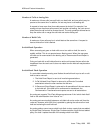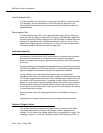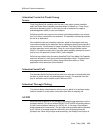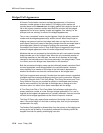
ASAI and Feature Interactions
Issue 7 May 1998
12-11
than one split with direct-agent calls waiting for the same agent, then the
direct-agent call with the longest queue waiting time is serviced first.
Agent Status Displays
The agent status lamps reflect the agent’s current work mode, whether it was
updated via the telephone set or via call control requests.
Announcements
Announcements played while a monitored call is in a split queue or as a result of
an announcement vector command create no event reports. Calls made directly
to announcement extensions result in the same event report sent to the adjunct as
calls made to station extensions. In either case, no Queued Event Report is sent
to the adjunct.
If a vector routes a call to an announcement extension via the route to vector
command, or if the Route Select capability routes a call to an announcement
extension, event reports equivalent to station extensions are sent to the adjunct
(assuming the call is an adjunct-monitored call).
If a user is hearing an announcement via an announcement vector command and
a valid Route Select is returned, the announcement is stopped, but because this
is an announcement while in vector processing, there are no event reports sent to
the adjunct.
Assist/Supervisor Assist
This feature can be accessed in the conventional way from the voice set if the set
is not ASAI-locked. In this case, the call is placed to the ECS-administered split
supervisor.
If the set is locked (under adjunct control), this feature may only be accessed via
the adjunct. This feature may also be accessed via the adjunct for sets that are
not locked. It is initiated when the adjunct requests a Third Party Make Call with
the assist flag set. The adjunct provides the supervisor extension. See Chapter 3
for interactions with other fields in the Third Party Make Call Request.
Whenever the “supervisor-assist” option is set in a Third Party Make Call, this call
is measured by CMS in the same manner as the ACD “assist” call (provided the
agent is logged into that split).
Automatic Answering
For direct-agent calls, receiving agents with automatic answering receive the
single zip tone when the call is delivered, as in the case with regular ACD calls.


















